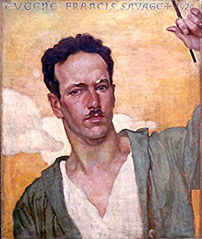SAVAGE, Eugene
Wikipedia has a nice article on

Eugene Savage who was born in Covington on March 29, 1883 (son of Hardy and Anna Weldon Savage – he had several brothers and sisters, including Mark, Mary, Anna and Walter) and lived a long life, passing away Oct 19, 1978 in Woodbury, Connecticut. Married Matilda Freitag Oct 17, 1908. They had one daughter, Dorothy. A natural bent to painting as well as sculpting he was known for the murals he worked on during the Works Projects Administration. Also the Bailey Fountain in the Grand Army Plaza (Brooklyn, NY) was one of his main works. In 1915, he was studying at the Chicago Art Institute and won the “Rome Prize” which enabled him to study at the American Academy in Rome. He also studied in Washington DC, and Munich. On Wikipedia you can see his work which prompted his winning the Rome Prize award, as well as a mural and other nifty art work. There, he attained his Bachelot of Arts. He received his Masters from Yale where he also taught for 28 years. He was quite active on various “high-profile art committees.” He was a member of the Fine Arts committee of the American Academy in Rome where he encouraged young artists studying there to use his idol, Thomas Hart Benton or even Savage himself. He spent quite a time in Hawaii where he painted large Hawaiian-themed mural finishing this in 1940. However, the ships they were designed for never saw them as they were converted to troop ships. Read the Wikipedia article to discover the strange place where they ended-up. Purdue, Columbia and Yale has murals done by this Fountain Countian, as well as many other places. One of the most impressive in my book is the colored glass mosaic map at the American Cemetery in Epinal, France. This depicts American and allied operations landing in southern France 15 August 1944. It is 54’ long and 14’ high. Although his large murals was and is the main rave, he himself enjoyed doing smaller pictures, especially those that he would make into murals (Brooklyn Daily Eagle 10 May 1925 p 24). When Eugene returned to Indiana, he was always treated with great respect and honor. In April 1925 when the Art Department of the Woman’s Department Club had him display his work, he was treated with a grand dinner at the Claypool Hotel and lunches in various places. Huge photos of the main four women (Indianapolis News Sat 11 April 1925 p 20) who planned the affair were in the newspaper and a very large article, pinpointing who all would be there which included many ladies from the Indiana Art Society of Chicago. He didn’t have the full time with just the ladies, however, as several important men were also available, including TC Steele, Warren Miller, George Mock, Adolph Shulz and several others who came to hear the great artist give his talk, “Art in the Home.”
Obituary from Bloomington, Illinois Pantagraph Sat 21 Oct 1978 p 26
Eugene F. Savage, 95, of Woodbury, Conn, formerly of Bloomington died Thursday in Woodbury. His funeral and burial will be in Woodbury. Mr. Savage, a sculptor and painter was a former professor of art at Yale University, New Haven, Conn. He taught at Yale from 1923-1958 and was named a professor emeritus. He studied at several colleges and art institutions and was a member of several artists organizations. He also won a number of art awards. He was appointed by President Herbert Hoover, President Franklin Delano Roosevelt as a member of the US Commission on Fine Arts. Mr. Savage was known for his style and technique as a painter of figures, portraits, murals and landscapes. He also was known for his glass mosaic work. He was born March 29, 1883 in Covington, Ind. He married Matilda Freitag Oct 17, 1908 at Stanford. She died Oct 27, 1966. Surviving are a daughter, Dorothy Crawford, Woodbury two grandchildren and a great grandchild.
In Eugene’s WWII Draft card information it noted he was 5’11”, blue eyed, gray haired, 180# with light complexion. His occupation was at Yale University. Born in Covington, Ind 29 March 1883. The family (Matilda being his next of kin) lived on Quaker Ridge Road in Ossining, NY. His signature was even artistic !!
On 22 Sept 1914, he made out his Passport Application and was listed as age 31 being 5’11 ½” tall, with a medium high forehead, blue eyes, large nose, full mouth, prominent chin, black hair, dark complexion and an oval face. In the summer of 1924, he had planned to visit in his birth area (Crawfordsville Review July 29th) but because of a commission to do some NY public building murals and because of the way he created these (similar to the ancient craftsmen whose mural decorations in Italy have defied the ravages of centuries) he was much in demand. A number of his works were purchased by private parties as well as art institutes.
In 1910, he and Matilda were living in Bloomington, Illinois and he is listed as an artist with his own studio. Matilda was a practicing physician at the time they met and were married in Chicago. Matilda and Eugene lost one child, but their daughter, Dorothy was born in Ossining 13 Feb 1922 and lived to be 95 years old, marrying Raymond G. Crawford in March 1945 there. Their two sons were left as well as one great grandchild at the time of his passing 19 October 1978.
Source: Attica Daily Tribune 11 Oct 1918 p 1
While Covington is proud of the record made by her boys on the battle front and in the camps, she also shares the glory of her sons in the world of fame. News comes through the columns of the Pittsburg Sun of the rapid strides of Gene W. Savage in the field of art. He is the son of Hardy and Ann Savage, born and reared in Covington where he received his early education. The Sun says in part: “The frieze for the central room of the American Red Cross building at Washington, DC originally erected as a memorial to the women of the Civil War is being painted in Pittsburgh. Eugene Francis Savage, a distinguished young American is the artist who is commissioned to do the work and Mrs. Savage is now in Pittsburg as professor of decorative painting in the school of applied design of Carnegie Institute of Technology assuming the duties of that post at the opening of the present term. “It will be remembered that Mr. Savage won the painting fellowship of the American Academy at Rome and went to Italy in 1912, remaining there for a year after the outbreak of the present war. He traveled extensively in Europe and studied at Munich. One of his best known works is his Roman envoy picture “Idealism,” painted by him in his last year at the American Academy in Rome and now hanging in the galleries of the International Exposition in New York. Mr. Savage was disqualified from army service by a defective heart but his wife who is a surgeon is awaiting final call from the Red Cross to go to Italy for the remainder of the war. She studies surgery in Munich and Vienna under the famous Lorenz in Rome at the Polyclinical Academy and at the Queen’s Dispensary. She was recently cabled for by the director of the academy. Mrs. Savage was formerly a Bloomington, Ill girl and has made rapid strides in surgery.”


